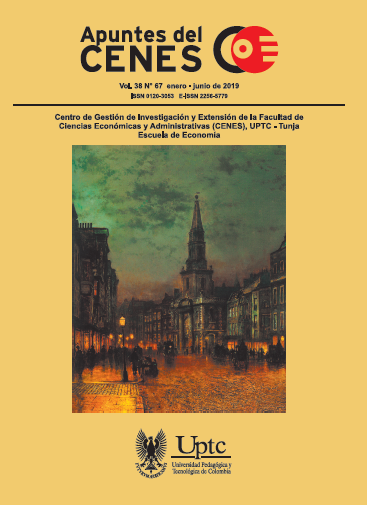Efectos de los anuncios de política monetaria y la credibilidad sobre las expectativas de inflación: evidencia para Colombia

Resumen
Este documento analiza los efectos de los anuncios del banco central sobre las expectativas de inflación para la economía colombiana. En particular, son estudiados los impactos de los pronunciamientos sobre la tasa de interés y los choques macroeconómicos sobre las tasas de inflación compensadas, dado el escenario de credibilidad de la política monetaria. La evidencia empírica es abordada por medio de un análisis de regresión con un modelo EGARCH para el período 2008-2016. Los resultados muestran que las expectativas de inflación responden a los anuncios de política. Además, los pronunciamientos fueron más efectivos en anclar las expectativas durante el período 2012-2016 y la mayor credibilidad de la política permitió que las expectativas fueran más estables frente a los choques externos.
Palabras clave
expectativas de inflación, bancos centrales, política monetaria, modelos econométricos
Biografía del autor/a
Juan Camilo Galvis Ciro
Profesor Facultad de Economía.
Referencias
- Bernanke, B., Laubach, T., Mishkin, F., & Posen, A. (1999). Inflation Targeting: Lessons from the International Experience. Princeton University Press, Princeton, 382p.
- Blinder, A., Ehrmann, M., Fratzcher, M., De Haan, J., & Jansen, D. (2008). “Central Bank Communication and Monetary Policy.” Journal of Economic Literature, 46(4), 910-945. DOI: https://doi.org/10.1257/jel.46.4.910
- Born, B., Ehrmann, M., & Fratzscher, M. (2014). “Central Bank Communication on Financial Stability.” The Economic Journal, 124(577): 701-734. DOI: https://doi.org/10.1111/ecoj.12039
- Ciro, J.C., & de Mendonça, H.F. (2017). “Effect of Credibility and Reputation on Discretionary Fiscal Policy: Empirical evidence from Colombia.” Empirical Economics, 53(4), 1529-1552. DOI: https://doi.org/10.1007/s00181-016-1177-2
- Clark, T., & Nakata, T. (2008). “Has the Behavior of Inflation and Long-term Inflation Expectations Changed?.” Economic Review Federal Reserve Bank of Kansas City, 93(1): 17-49.
- de Mendonça, H. F. 2007. “Towards Credibility from Inflation Targeting: The Brazilian Experience.” Applied Economics, 39(20): 2599–2615 DOI: https://doi.org/10.1080/00036840600707324
- De pooter, M., Robitaille, P., Walker, I., & Zdinak, M. (2014). “Are Long-Term Inflation Expectations Well Anchored in Brazil, Chile and Mexico?.” International Journal of Central Banking, 10(2): 337-400. DOI: https://doi.org/10.17016/IFDP.2014.1098
- Ehrmann, M., & Fratzscher, M. (2007). “Communication and Decision-Making by Central Bank Committees - Different Strategies, Same Effectiveness.” Journal of Money, Credit and Banking, 39(3): 509-541. DOI: https://doi.org/10.1111/j.0022-2879.2007.00034.x
- Ehrmann, M., Fratzscher, M. Gürkaynak, R., & Swanson, E. (2011). “Convergence and Anchoring of Yield Curves in the Euro Area.” The Review of Economics and Statistics, 93(1): 350-364. DOI: https://doi.org/10.1162/REST_a_00055
- Égert, B. (2009). “The Impact of Monetary and Commodity Fundamentals, Macro News and Central Bank Communication on the Exchange Rate: Evidence from South Africa”, Open Economies Review, 21(5): 655-677. DOI: https://doi.org/10.1007/s11079-009-9118-8
- Engle, R. (1982). “Autoregressive conditional heteroscedasticity with estimates of the variance of United Kingdom inflation.” Econometrica, 50(4): 987–1008. DOI: https://doi.org/10.2307/1912773
- Galati, G. Poelhekke, S., & Zhou, C. (2009). “Did the Crisis Affect Inflation Expectations?.” International Journal of Central Banking, 7(1): 167-207.
- Gürkaynak, R., Levin, A., & Swanson, E. (2010). “Does Inflation Targeting Anchor Long-Run Inflation Expectations? Evidence from Long-Term Bond Yields in the U.S., U.K., and Sweden.” Journal of the European Economic Association, 8(6): 1208-1242. DOI: https://doi.org/10.1162/jeea_a_00023
- Jansen, D., & De Haan, D. (2007). The Importance of Being Vigilant: Has ECB Communication Influenced Euro Area Inflation Expectations?. CESifo Working Paper Series No. 2134: 1-29. Munich. DOI: https://doi.org/10.2139/ssrn.1027576
- Johnson, D. (2003). “The Effect of Inflation Targets on the Level of Expected Inflation in Five Countries.” Review of Economics and Statistics, 85(4): 1076-81. DOI: https://doi.org/10.1162/003465303772815952
- Kennedy, M., & Palerm, A. (2014). “Emerging Market Bond Spreads: The Role of Global and Domestic Factors from 2002 to 2011.” Journal of International Money and Finance, 43(1): 70–87. DOI: https://doi.org/10.1016/j.jimonfin.2013.12.008
- Kliesen, K., & Schmid, F. (2004). “Monetary PolicyActions, Macroeconomic Data Releases, and Inflation Expectations.” Federal Reserve Bank of St Louis Review, 86(3): 9–21. DOI: https://doi.org/10.3886/ICPSR01301.v1
- Kuttner, K. 2001. “Monetary Policy Surprises and Interest Rates: Evidence from the FED FUNDS Futures Market.” Journal of Monetary Economics, 47(3): 523–544. DOI: https://doi.org/10.1016/S0304-3932(01)00055-1
- Levieuge, G., Lucotte, Y., & Ringuedé. S. (2015). Central Bank Credibility and the Expectations Channel: Evidence Based on a New Credibility Index. National Bank of Poland Working Papers 209: 1–45. Warsaw. DOI: https://doi.org/10.2139/ssrn.2561774
- Levin, A., Natalucci, F., & Piger, J. (2004). “The Macroeconomic Effects of Inflation Targeting.” Federal Reserve Bank of St. Louis Review, 86(4): 51-80. DOI: https://doi.org/10.20955/r.86.51-80
- López E., Montes, E., Garavito, A, & Collazos, M. (2013). La economía petrolera en Colombia. Relaciones intersectoriales e importancia en la economía nacional. Borradores de Economía, No. 566: 1-56. Bogotá.
- Mankiw, N., Reis, R., & Wolfers, J. (2003). Disagreement about Inflation Expectations. NBER Macroeconomics Annual, Vol. 18: 209-268. DOI: https://doi.org/10.1086/ma.18.3585256
- Moessner, R. (2015). “Reactions of real yields and inflation expectations to forward guidance in the United States.” Applied Economics, 47(26): 2671-2682. DOI: https://doi.org/10.1080/00036846.2015.1008759
- Montes, G., Oliveira, L., Curi, A., & Nicolay, R. (2016). “Effects of transparency, monetary policy signalling and clarity of central bank communication on disagreement about inflation expectations.” Applied Economics, 48(7): 1-18. DOI: https://doi.org/10.1080/00036846.2015.1083091
- Montes, G. (2013). “Credibility andmonetary transmission channels under inflation targeting: an econometric analysis from a developing country.” Economic Modelling, 30(C): 670–684. DOI: https://doi.org/10.1016/j.econmod.2012.09.035
- Nelson, D. (1991). “Conditional Heteroskedasticity in Asset Returns: A new Approach”, Econometrica, 59(2): 349-380. DOI: https://doi.org/10.2307/2938260
- Rincón, H., & Rodríguez, N. (2016). Pass-Through of Exchange Rate Shocks on Inflation: A Bayesian Smooth Transition VAR Approach. Borradores de Economía, No. 930: 1-75. Bogotá.
- Vargas, H., González, A., González, E., Romero, J., & Rojas, L. (2010). Assessing inflationary pressures in Colombia. BIS Papers, Bank for International Settlements, No. 49 (August): 129-171. Basel.
- Woodford, M. (2005). Central Bank Communication and Policy Effectiveness. NBER Working Paper No. 11898: 1-67. Cambridge. DOI: https://doi.org/10.3386/w11898
